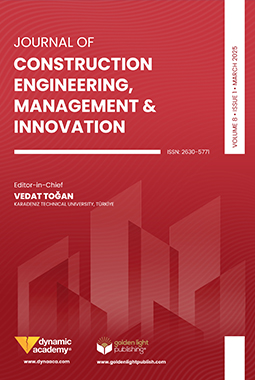ISSN:2630-5771
Journal of Construction Engineering, Management & Innovation
ARTICLES
Önder Halis Bettemir
Quantity take-off and cost estimation are the most time consuming and costly work items of the project planning phase. A structure consists of significantly many components, and quantities of all of these work items have to be computed as well as necessary workmanship and materials should be determined. If quantity take-off is computed incorrectly, then cost will also be estimated erroneously. Therefore computation of quantity take-off correctly has vital importance. Each constructed structure is unique, for this reason quantity take-off has to be prepared for every structure. In this study, a spreadsheet application is developed for the computation of quantity take-off with minimum human intervention and endeavor. Positions of the load bearing sections and architectural elements are defined by nodes and dimensions of these elements are identified by entering related information to data cells. Topologies of the structural and architectural elements are formed to determine the neighborhood and intersections. Voids are computed and subtracted to obtain exact quantities. Necessary materials and workmanships are determined by using database and cost is estimated by using unit prices of these items. Quantity take-off and cost is computed fast and accurately with minimized data input. Consequently, design offices can avoid purchasing expensive quantity take-off software by utilizing this approach.
https://doi.org/10.31462/jcemi.2018.03108117
Mohammad Azim Eirgash
Tayfun Dede
Abstract
In this paper, a multi-objective optimization model based on modified adaptive weight approach and improved teaching-learning based optimization (MAWA-ITLBO) algorithm is proposed for the solution of time-cost trade-off problems. The MAWA-ITLBO algorithm is the improved version of the basic MAWA-TLBO algorithm by adding the concept of the number of teachers as well as adaptive teaching factor. The effects of these parameters in TLBO are investigated in order to demonstrate the variation of the Pareto front solution. Thereby, the performance of the MAWA-ITLBO is compared to the existing methods using a well-known 18-activity benchmark problem. A 63-activity problem is also included in computational experiments to validate the efficiency of the proposed MAWA-ITLBO for a medium-scale problem. The results obtained by using the MAWA-ITLBO are compared with those obtained by using the basic MAWA-TLBO, genetic algorithm (GA), and ant colony optimization (ACO) algorithms. The obtained results demonstrate that the utilized MAWA-ITLBO is able to provide a superior set of Pareto-front solutions than that of previously proposed models.
https://doi.org/10.31462/jcemi.2018.03118128
Moacir Kripka
Gilnei Arthur Drehmer
The application of optimization to the solution of practical structural engineering problems has been very limited, despite the great development of the techniques. One of the main reasons for this is the complexity of the generated models, which employ nonlinear functions and generate a space of nonconvex solutions. In addition, most design variables, as in the case of steel profiles, can only assume discrete values. Traditional methods of mathematical programming are very limited in solving problems with these characteristics, opening space to the usage of heuristic methods and, more specifically, to metaheuristic methods. The main advantage of this class of methods is the fact that they only involve values of the functions in the optimization process, regardless of the existence of unimodality or even continuity in the derivatives of the functions involved. The present work presents the application of a heuristic method, the simulated annealing method, to the optimization of steel trusses with parallel chords, also called flat trusses. Initially, several usual configurations of trusses were analyzed, aiming to identify which led to the lowest cost. The top chord coordinates were also included as design variables, with the purpose of verifying the relations between span and height normally indicated in the literature as the most economical. Among the results, it was verified that the inclusion of the height of the truss among the design variables can lead to a significant additional cost savings.
https://doi.org/10.31462/jcemi.2018.03129138
Ebru KALKAN
Fatih
Ahmet Can ALTUNIŞIK
A parametric model is a computer representation of a design made with geometric shapes with constant and variable properties. Variable attributes are called parameters. The designer can change the parameters in the parametric model to search for different alternative solutions to the problems in the model. The parametric model is obtained automatically by changing the only parameters without needing to changing or redraw. In this study, it is aimed to give information about the concepts, advantages, application areas and applicability of parametric modeling. Also modeled using parametric modeling and examples from a numerical example selected as the best student project in the category of international competition are given. In this study, it has been seen that parametric modeling provides convenience in terms of time and application. This method, which is among the latest trends of the technology age, accelerated the development of works in the field of architecture, civil engineering and industry.
https://doi.org/10.31462/jcemi.2018.03139146


